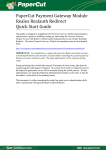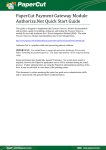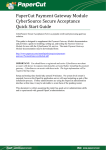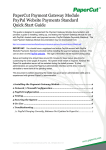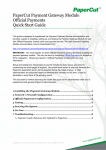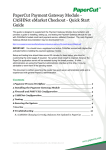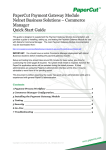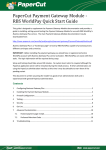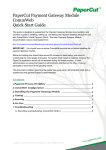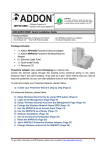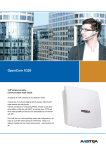Download Payment Gateway Module - CyberSource - Quick Start
Transcript
PaperCut Payment Gateway Module
CyberSource Quick Start Guide
This guide is designed to supplement the Payment Gateway Module documentation
and provides a guide to installing, setting up, and testing the Payment Gateway
Module for use with CyberSource’s Hosted Order Page (HOP) service. The main
Payment Gateway Module documentation may be downloaded from:
http://www.papercut.com/anonftp/pub/pcng/ext/payment-gateway/PaymentGatewayModule.pdf
CyberSource is a popular credit card processing gateway solution.
IMPORTANT: You should have a registered and active CyberSource merchant
account with Hosted Order Page functionality activated before installing the payment
gateway. CyberSource can assist with these tasks. The login information will be
required during setup.
Setup and testing time should take around 30 minutes. No system level restart is
required; however the PaperCut application server will be restarted during the install
process. If other administrators are using the PaperCut administration interface at this
time, it may be advisable to warn them of the pending restart.
This document is written assuming the reader has good server administration skills
and is experienced with general PaperCut administration.
PaperCut - Payment Gateway Module - CyberSource - Quick Start Guide
Stage 1: Configuring the CyberSource HOP
Several pieces of information are required from CyberSource before PaperCut can
send users to the HOP. These can all be gained from the CyberSource Business
Center as follows:
1. Log into the CyberSource Business Center.
2. Navigate to Tools & Settings -> Hosted Order Page -> Settings. If
the ‘Hosted Order Page’ menu does not appear then HOP functionality has not
been enabled on your CyberSource account. Contact CyberSource to enable
HOP.
3. Find the setting Appearance -> Receipt Page -> Receipt Response URL.
Enable the checkbox marked ‘This URL is my custom receipt page’. In the
text box enter:
http://papercut:9191/rpc/gateway/cybersource/user
Where ‘papercut’ is the hostname of the system running PaperCut. This
hostname does not necessarily need to resolve externally (i.e. from the
internet), because it is retrieved by the user and not CyberSource. The user is
redirected to this URL (or to the Decline Response URL) after making a
payment.
4. Find the setting Appearance -> Decline Page -> Decline Response URL.
Enable the checkbox marked ‘This URL is my custom decline page’. In the
text box enter:
http://papercut:9191/rpc/gateway/cybersource/user
Replacing ‘papercut’ as for the previous step.
5. Find the setting Notifications -> Addresses and Options -> Merchant
POST URL. Enable the checkbox for this setting. In the textbox enter:
http://papercut.myorg.edu/rpc/gateway/cybersource/transaction
Where ‘papercut.myorg.edu’ is a hostname that can be resolved from the
internet. CyberSource will send transaction details to this address. The
section ‘Stage 3: Firewall Configuration’ has more information about ensuring
that this address is available.
6. Press the Update button.
7. Navigate to Tools & Settings -> Hosted Order Page -> Security.
8. Under ‘Generate Security Script’ select the radio button ‘JSP’ and press
‘Submit’.
9. A download box will appear for a file ‘HOP.jsp’. Save this file in a safe place;
it contains sensitive information, and will be required in the next stage.
Copyright © 2009-2012 PaperCut Software International Pty. Ltd., All Rights Reserved.
2 of 8
PaperCut - Payment Gateway Module - CyberSource - Quick Start Guide
Stage 2: Installing the Payment Gateway Module
1. The Payment Gateway Module will function during the PaperCut NG 40 day
trial period. After this, the module must be licensed. If you have been
supplied with a new license take the time to install this now. The license
install procedure is documented in the PaperCut user manual chapter
‘Licensing and Support’.
2. Download the Payment Gateway Module from the PaperCut website at
http://www.papercut.com/anonftp/pub/pcng/ext/payment-gateway/pcng-payment-gatewaymodule.exe
3. Install the module into the same directory as PaperCut NG. This is normally:
C:\Program Files\PaperCut NG
4. Open the file:
[app-path]\server\lib-ext\ext-payment-gatewaycybersource.properties
in a text editor such as Notepad.
5. Locate the line cybersource.enabled=N and change the N to Y. This will
enable the CyberSource module.
6. Locate the line cybersource.merchant-id and enter your merchant id. The
merchant id assigned by CyberSource and used to log into the CyberSource
Business Center.
7. Locate the line cybersource.public-key
This setting is obtained from the HOP.jsp file that was saved in Stage 1. Open
the HOP.jsp file in a text editor (such as WordPad).
Find the section near the top of the file that reads:
private String getSharedSecret() {
return "abcdef123456…”;
}
Note: in older versions of CyberSource it was called “getPublicKey” – look
for this if “getSharedSecret” does not exist.
The text inside the quotation marks (“abcdef123456” in this case) is the
‘public key’. Copy this text from inside the quotation marks only, and paste it
next to the cybersource.public-key setting, on the right side of the = sign.
There should be no spaces or newlines in the value.
8. Repeat step 9 for the setting cybersource.serial-number using the
getSerialNumber section.
Copyright © 2009-2012 PaperCut Software International Pty. Ltd., All Rights Reserved.
3 of 8
PaperCut - Payment Gateway Module - CyberSource - Quick Start Guide
9. Configure other options in this file as discussed in General Configuration
Options in the Payment Gateway Module documentation, or by referring to the
comments in the file itself. Options include limits on the amount to transfer,
access groups and custom error messages.
You may like to enable a group restriction to limit access to administrators
until configuration is complete.
10. Save the file and exit the text editor.
11. Restart the PaperCut Application Server service via Control Panel ->
Administrative Tools -> Services and wait 30 seconds.
12. Check the end of the log file at [app-path]\server\logs\server.log for
any obvious error messages.
Copyright © 2009-2012 PaperCut Software International Pty. Ltd., All Rights Reserved.
4 of 8
PaperCut - Payment Gateway Module - CyberSource - Quick Start Guide
Stage 3: Firewall Configuration
The CyberSource server communicates with the PaperCut server via HTTP to the
URL specified in the ‘Merchant POST URL’ setting in Stage 1. The CyberSource
documentation recommends using ports 80 or 8080 for HTTP or port 443 for HTTPS
(see Stage 5: Security for details). You will need to ensure that CyberSource is able
to contact the PaperCut server via the internet on this hostname and port. This will
usually involve the following network changes:
1. Set up a public DNS entry to ensure the PaperCut server is publicly accessible
via a friendly name (e.g. papercut.myorg.edu). This will be the same name
used for the ‘Merchant POST URL’ setting in Stage 1.
2. Set up external firewall rules to port forward from the public address port (e.g.
port 80) to the PaperCut server port 9191 (or 9192 for HTTPS).
It is important that the firewall policy only applies to external hosts. Internal
hosts will require direct access to the PaperCut server.
During testing it may be appropriate to open access from any host, then lock
down access to the CyberSource IP address range once it has been determined.
Once a test transaction has been made via HTTP the CyberSource server IP
address(es) may be gained from the payment gateway event log file (located at
[app-path]/server/logs/payment-gateway/event.log).
At the time of writing this address range was: 66.185.186.0/255
3. Accessing the following URL with a web browser will display a simple
confirmation page containing the current time, and can be used to test external
access:
http://papercut.myorg.edu:9191/rpc/gateway/cybersource
Copyright © 2009-2012 PaperCut Software International Pty. Ltd., All Rights Reserved.
5 of 8
PaperCut - Payment Gateway Module - CyberSource - Quick Start Guide
Stage 4: Testing
The Payment Gateway Module for CyberSource is now ready for testing. This test
will involve performing a live transaction with a real credit card, testing real-world
end-to-end functionality. Afterwards the payment may be voided/credited/refunded
via the CyberSource Business Center. Note that transaction fees may be incurred for
the payment or refunding.
1. Log into the PaperCut user web interface at http://papercut:9191/user
2. A new link called Add Credit should appear on the left. Click this link.
3. Select an amount to add and press Continue.
4. You should now be redirected to the CyberSource HOP for payment. Enter
the payment details including a valid credit card number and associated details
as requested.
5. Continue and confirm that the value is placed on the user’s PaperCut account
and the transaction is listed in their transaction history. See the
Troubleshooting section if you have any problems.
6. The transaction should appear in the CyberSource Business Center, and may
be voided or credited.
Note: PaperCut will connect to CyberSource in “live” mode by default. If you have
configured a CyberSource account in “test” mode, you can configure PaperCut to
connect to the test order page by editing the “cybersource.hosted-order-pageurl” setting in the “[app-path]\server\lib-ext\ext-payment-gatewaycybersource.properties” config file. Comments in the file contain the default
“test” and “live” page URLs to configure.
Copyright © 2009-2012 PaperCut Software International Pty. Ltd., All Rights Reserved.
6 of 8
PaperCut - Payment Gateway Module - CyberSource - Quick Start Guide
Stage 5: Security
Transaction details are sent from CyberSource to PaperCut via a HTTP POST (to the
‘Merchant POST URL’), and along with the user when returning to the PaperCut web
interface. These details are protected from forgery by several signatures, signed using
a private key specific to your setup (found in HOP.jsp, which should be protected).
While these transaction details do not contain the user’s full card number, they may
contain other information considered private, such as the billing address or email
address. The security conscious may prefer to have these details sent over HTTPS
instead of HTTP.
Enabling HTTPS involves two parts:
1. Ensuring that CyberSource POSTs transaction details to PaperCut via HTTPS.
2. Ensuring that users are redirected from CyberSource back to PaperCut via
HTTPS.
Part 1 requires that PaperCut has been configured with a certificate signed by a trusted
certificate authority (CA), so that CyberSource can validate the connection. For
information about installing a CA signed certificate see the user manual section
Appendix A. Tools (Advanced) -> SSL/HTTPS Key Generation.
Once PaperCut has been configured with a certificate the three URLs configured in
the CyberSource Business Center (Receipt Response URL, Decline Response URL
and Merchant POST URL) may be configured to use ‘https://’ and port 443. E.g. for
the Merchant POST URL:
https://papercut.myorg.edu/rpc/gateway/cybersource/transaction
This public address should then port forward to the PaperCut server on port 9192.
Stage 6: Go-Live
If a group restriction was enabled in Stage 2 it can now be removed or altered to allow
access to end-users. Your system is now live and will accept and charge credit cards.
Copyright © 2009-2012 PaperCut Software International Pty. Ltd., All Rights Reserved.
7 of 8
PaperCut - Payment Gateway Module - CyberSource - Quick Start Guide
Troubleshooting
Administrators may find information in the following log files useful when trying to
troubleshoot setup/configuration problems or issues reported by end-users.
Payment Gateway Event Log:
[app-path]\server\logs\payment-gateway\event.log
This log contains gateway specific error messages and events.
Application Log:
[app-path]\server\logs\server.log
This log contains general application specific error messages and events.
Transaction Log:
[app-path]\server\logs\payment-gateway\transaction.log
This log contains a list of successful transactions in a tab-delimited form.
Please feel free to contact the PaperCut Software Development Team at
[email protected] if you require assistance.
Copyright © 2009-2012 PaperCut Software International Pty. Ltd., All Rights Reserved.
8 of 8








